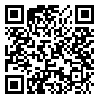BibTeX | RIS | EndNote | Medlars | ProCite | Reference Manager | RefWorks
Send citation to:
URL: http://salmandj.uswr.ac.ir/article-1-835-en.html
2- Department of Speech Therapy, University of Social Welfare and Rehabilitation Sciences, Tehran, Iran.
Objectives: So far, The Persian Aphasia Battery (PAB) has been widely used by clinicians as the first clinical linguistic test to assess and rehabilitate aphasia and language impairments among adult Iranian brain damaged aphasic patients (Fluent / Non-Fluent). The first version was provided based on linguistic and cultural adaptations on healthy Persian speaking adults and has been used by clinicians for more than 20 years. The purpose of this study was to report on the validity and reliability of PAB, based on the results obtained from aphasic patients.
Methods & Materials: In this research we report on data obtained from 57 Persian speaking brain damaged patients with the age range of 19 to 83 years who were recruited from clinics in Tehran, Mashhad, Karaj, Yazd, Isfahan, and Shiraz cities, Iran during 2006 to 2011 through purposeful sampling system. The clinical language profiles of the patients were checked by an experienced speech language pathologist (SLP) for diagnosis. The internal consistency of the Battery, the subtests and items in each subtest were assessed based on the Cronbach α index. The internal consistency of the structure of the Battery was based on the correlation between its subtests and each language skill.
Results: The overall measure of internal consistency of the Battery was 0.93 and the internal consistency of major language skills was significant (r=0.3-0.76, P<0.05). The subtests had high to medium internal consistencies (r=0.63-0.83, P<0.01). The profiles of different language skills and subtests of PAB are consistent with the diagnosis of aphasia type by expert SLP clinicians.
Conclusion: Based on the obtained validity and reliability measures, the Battery has high internal consistency
and clinical utility and can be used for differential diagnosis and measuring severity of aphasia in
clinical linguistic studies among adult Persian speaking brain damaged patients.
Received: 2015/07/09 | Accepted: 2015/10/18 | Published: 2016/01/01
| Rights and permissions | |
 |
This work is licensed under a Creative Commons Attribution-NonCommercial 4.0 International License. |





